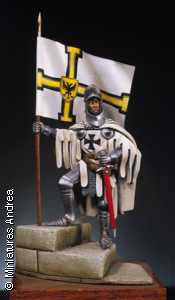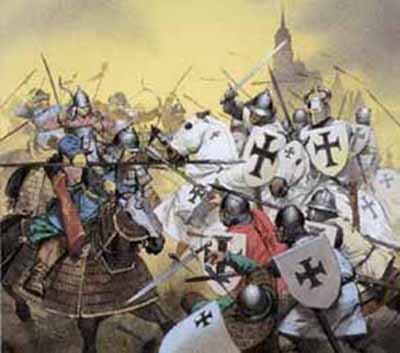
Although most people who have heard of the Crusades would correctly say that they were fought between Christians and Muslims in the Holy Land, I'd venture to say that many people would be unaware that Crusades were also called against other enemies of the Church in the Middle Ages. The Spanish Reconquista was one such Crusade. The Albigensian Crusade in Southern France was another Crusade. But as the Middle Ages continued, Crusades were also called against the pagan peoples of Eastern Europe.

The shock troops of the Church in Eastern Europe were the Teutonic Knights, a military order like the Templars and Hospitallers. They were originally organized under the Templar Rule. They grew to be so powerful a force that they ruled their own state, which was the basis for the politicial boundaries of Prussia, and later the core of modern Germany. Their dominion extended into Poland and parts of the Ukraine and Russia.

The heraldry of the Teutonic Knights was black on white, with gold trim and other details. Their equipment and iconogrpahy was particularly gothic in design. The extensive detail in their uniforms, based on a simple color scheme has made them popular subjects for military modelers, as evidenced by the accompanying photographs.

The best known battle involving the Teutonic Knights was the so-called "Ice Battle" related in the epic tale of Alexander Nevsky, and most recently riffed on in the Clive Owen film version of
King Arthur. The knights were fighting a winter campaign against the Russian pagans, led by Nevsky. Nevsky lured them onto a frozen lake. The ice cracked under the weight of the heavily armored knights and charging horses, and hundreds of the brothers drowned.

With the best of their Order lost in such a humiliating defeat, the Teutonic Knights abandoned the campaign.

Like all of the Crusading Orders, the Teutonic Knights were renowned for their fierce devotion to the Christian Faith. However, also like the Templars, they were dogged by rumors of being more interested in worldly affairs, wealth, and power. Their were undeniably ruthless in the pursuit of their cause.


Perhaps the most chilling legacy of the Teutonic Knights is not their fault at all. Due to their Germanic origins, martial prowess, and reputation for devotion to their cause, Hitler used them as an inspirational model for his SS. The example even went so far as to build SS retreats using the floorplan on Teutonic Order keeps.

 Although most people who have heard of the Crusades would correctly say that they were fought between Christians and Muslims in the Holy Land, I'd venture to say that many people would be unaware that Crusades were also called against other enemies of the Church in the Middle Ages. The Spanish Reconquista was one such Crusade. The Albigensian Crusade in Southern France was another Crusade. But as the Middle Ages continued, Crusades were also called against the pagan peoples of Eastern Europe.
Although most people who have heard of the Crusades would correctly say that they were fought between Christians and Muslims in the Holy Land, I'd venture to say that many people would be unaware that Crusades were also called against other enemies of the Church in the Middle Ages. The Spanish Reconquista was one such Crusade. The Albigensian Crusade in Southern France was another Crusade. But as the Middle Ages continued, Crusades were also called against the pagan peoples of Eastern Europe. The shock troops of the Church in Eastern Europe were the Teutonic Knights, a military order like the Templars and Hospitallers. They were originally organized under the Templar Rule. They grew to be so powerful a force that they ruled their own state, which was the basis for the politicial boundaries of Prussia, and later the core of modern Germany. Their dominion extended into Poland and parts of the Ukraine and Russia.
The shock troops of the Church in Eastern Europe were the Teutonic Knights, a military order like the Templars and Hospitallers. They were originally organized under the Templar Rule. They grew to be so powerful a force that they ruled their own state, which was the basis for the politicial boundaries of Prussia, and later the core of modern Germany. Their dominion extended into Poland and parts of the Ukraine and Russia. The best known battle involving the Teutonic Knights was the so-called "Ice Battle" related in the epic tale of Alexander Nevsky, and most recently riffed on in the Clive Owen film version of King Arthur. The knights were fighting a winter campaign against the Russian pagans, led by Nevsky. Nevsky lured them onto a frozen lake. The ice cracked under the weight of the heavily armored knights and charging horses, and hundreds of the brothers drowned.
The best known battle involving the Teutonic Knights was the so-called "Ice Battle" related in the epic tale of Alexander Nevsky, and most recently riffed on in the Clive Owen film version of King Arthur. The knights were fighting a winter campaign against the Russian pagans, led by Nevsky. Nevsky lured them onto a frozen lake. The ice cracked under the weight of the heavily armored knights and charging horses, and hundreds of the brothers drowned. With the best of their Order lost in such a humiliating defeat, the Teutonic Knights abandoned the campaign.
With the best of their Order lost in such a humiliating defeat, the Teutonic Knights abandoned the campaign. Like all of the Crusading Orders, the Teutonic Knights were renowned for their fierce devotion to the Christian Faith. However, also like the Templars, they were dogged by rumors of being more interested in worldly affairs, wealth, and power. Their were undeniably ruthless in the pursuit of their cause.
Like all of the Crusading Orders, the Teutonic Knights were renowned for their fierce devotion to the Christian Faith. However, also like the Templars, they were dogged by rumors of being more interested in worldly affairs, wealth, and power. Their were undeniably ruthless in the pursuit of their cause.
 Perhaps the most chilling legacy of the Teutonic Knights is not their fault at all. Due to their Germanic origins, martial prowess, and reputation for devotion to their cause, Hitler used them as an inspirational model for his SS. The example even went so far as to build SS retreats using the floorplan on Teutonic Order keeps.
Perhaps the most chilling legacy of the Teutonic Knights is not their fault at all. Due to their Germanic origins, martial prowess, and reputation for devotion to their cause, Hitler used them as an inspirational model for his SS. The example even went so far as to build SS retreats using the floorplan on Teutonic Order keeps.







2 comments:
I have heard tales of Hitler holding some kind of crazy ceremony at said retreat with the cream of the crop graduates from SS school involving a severed head or severing a head and such. Have you heard this and if so, can you elaborate?
Uh, no. I don't know anything about that.
I can tell you that one of the heresies the Templars were accussed of in 1315 was that they worshipped a "brazen head." The stories surrounding that have been strange and varied. Some say it was a mechanical model head which spoke to them. Others say it was the severed, mummified head of John the Baptist. A few believe it was the bronzed head of John the Baptist. Some think it was a gilded skull. And there are even a few who believe it to be Jesus' head -- which of course would be highly heretical and devastating to the underpinnings of the Christian faith.
However, no one has ever proven such a head existed.
I have seen this legend connected to the Teutonic Knights, but never convincingly. Whether the Nazis used some kind of variation on this, I don't know. I wouldn't put anything past them.
Post a Comment